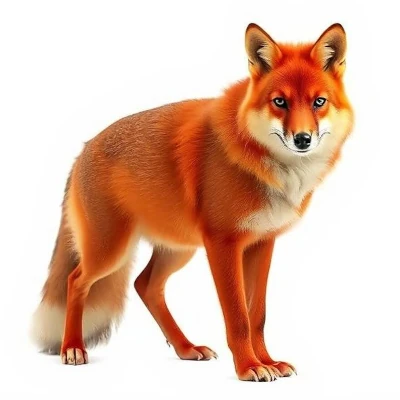
The Asian Red Wolf (Cuon alpinus), also known as the Dhole, is a rare and little-known canid native to the forests and mountains of Asia, particularly in India, China, and Southeast Asia. With its reddish coat and complex social behavior, it stands out from other wild canids.
The Asian Red Wolf is a medium-sized canid, measuring between 45 and 55 cm at the withers and weighing between 12 and 20 kg. It has a dense reddish coat, a bushy tail, and rounded ears. Its muzzle is short, and its legs are adapted for running on rough terrain.
The Asian Red Wolf (Cuon alpinus) belongs to the Canidae family. Here is its scientific classification:
This wolf is the only member of the genus Cuon, and although it shares traits with wolves and wild dogs, it has unique adaptations to its environment.
The Asian Red Wolf primarily inhabits dense forests, mountainous areas, and grasslands in Asia. It can be found in India, China, Indonesia, and parts of the Himalayas. Its habitat is often far from urban areas, making it a discreet and difficult species to observe.
Unlike many solitary canids, the Asian Red Wolf is very social and lives in packs of 5 to 12 individuals. These packs hunt together and communicate through a series of whistles and high-pitched cries. They are known for their cooperation during hunting, which allows them to capture larger prey.
The Asian Red Wolf is a strict carnivore, feeding mainly on deer, wild boar, and small mammals. Occasionally, it may also hunt birds or reptiles. Unlike other predators, it consumes its prey quickly to avoid competition with tigers or leopards.
The Asian Red Wolf is classified as an endangered species by the IUCN due to habitat fragmentation and the decline of its prey. Deforestation and conflicts with local livestock farmers also threaten its survival. Conservation programs aim to protect its natural areas.
The Asian Red Wolf (Cuon alpinus) shares evolutionary links with other Asian canids, notably the Golden Jackal (Canis aureus) and the African Wild Dog (Lycaon pictus). Although morphologically different, these species share similar social behaviors.
Observing an Asian Red Wolf in the wild is a rare privilege. Here are some tips to maximize your chances while respecting the animal: